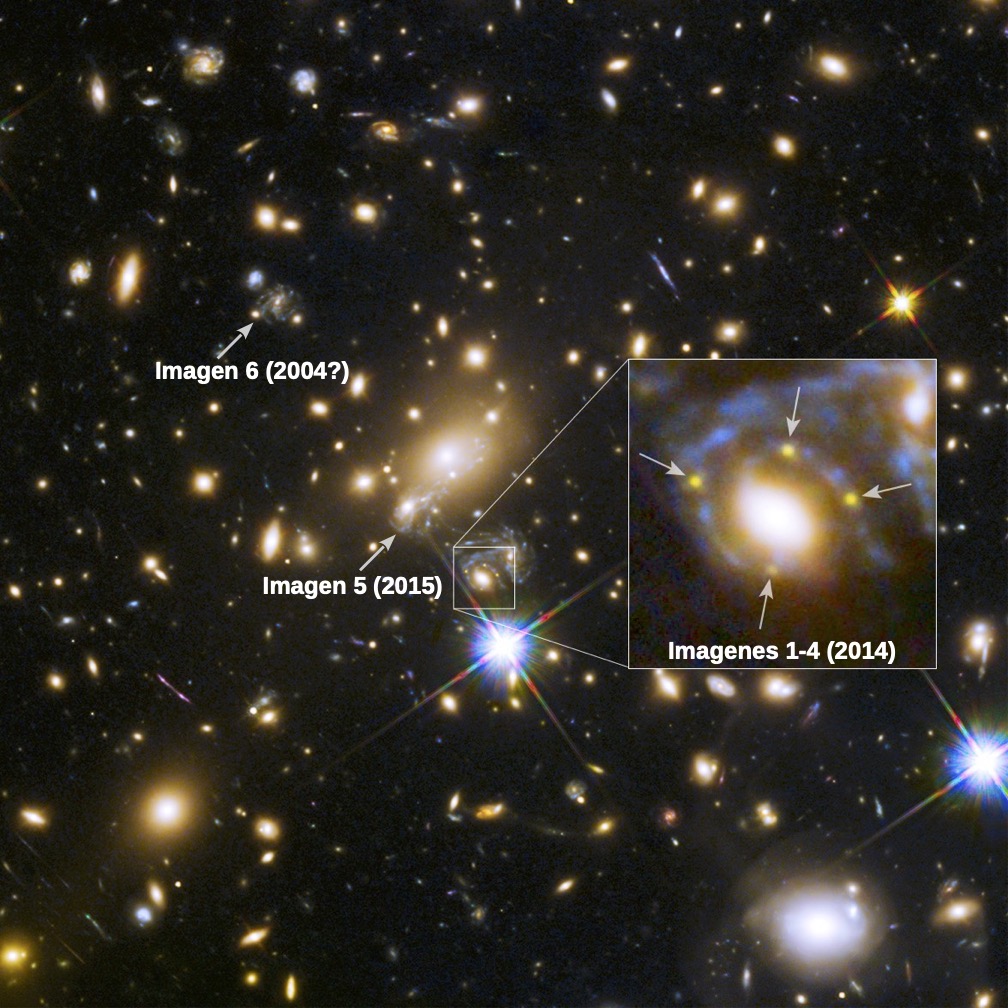
Galaxy cluster MACS1149. The supernova was first imaged in 2014. The fifth image was detected a year later in 2015.
The time difference between the two images has allowed the Hubble constant to be estimated. / ESA, Hubble and NASA.
An international research led by the University of Minnesota and involving José María Diego could accurately determine the age of the Universe and the speed at which it is expanding around us
11/05/2023
Thanks to data obtained from a supernova magnified in four images, a team led by researchers from the University of Minnesota, including IFCA (CSIC-UC) researcher José María Diego, has used a pioneering technique to measure the expansion rate of the Universe. These measurements open up a long-standing debate that could help the scientific community to determine more precisely the age of the Universe and to better understand the cosmos. The work has been published in the journal Science and in The Astrophysical Journal.
In astronomy, there are two measurements that indicate the expansion of the Universe, known as the "Hubble constant". One is calculated from observations of supernovae, and the second part of the "cosmic microwave background", i.e. the radiation that began to flow freely through the Universe shortly after the Big Bang.
However, these two measurements differ from each other by about 10%, which has sparked a wide debate among the physics and astronomy community. If both measurements are accurate, it would mean that the current expert theory of the composition of the Universe is incomplete.
"If new independent measurements confirm this disagreement between the two measurements of the Hubble constant, it would become a chink in the armour of our understanding of the cosmos," says Patrick Kelly, lead author of both papers and a professor in the School of Physics and Astronomy at the University of Minnesota. "The big question is whether there is a problem with one or both of the measurements. Our research addresses this using an independent and completely different way of measuring the expansion rate of the Universe," explains Kelly.
The team, led by the University of Minnesota and including IFCA researcher José María Diego, has been able to calculate this value using data from a supernova discovered by Kelly in 2014 - the first case of a supernova with multiple images, i.e. the telescope captured four different images of the same cosmic event.
In this case, the IFCA researcher has modelled one of the lens types, used in a previous project, WSLAP+. "A couple of years ago we did a very similar previous work, where Jesús Vega-Ferrero, a former IFCA colleague, was lead author," explains Diego.
These four images of the supernova have been obtained because it was gravitationally attracted by a cluster of galaxies, a phenomenon in which the mass of the cluster bends and broadens its light. Thanks to the time between the appearance of the 2014 and 2015 images, the researchers were able to measure the Hubble constant using a theory developed in 1964 by the Norwegian astronomer Sjur Refsdal, which had previously been impossible to put into practice.
Galaxy cluster Abell 2537. / ESA, Hubble and NASA.
Closer to knowing the age of the universe
"The researchers' findings do not settle the debate absolutely," says Kelly, but they do provide more information about the problem and bring physicists closer to obtaining the most accurate measure of the age of the universe.
"Our measurement favours the cosmic microwave background value, although it cannot exclude the value obtained with closer supernovae," says Kelly. "If observations of future supernovae that are also gravitationally bound by clusters yield a similar result, then this would identify a problem with the current value of the supernova, or with our understanding of the dark matter in galaxy clusters.
In addition, this work, involving 28 institutions on four continents (America, Europe, Asia, and Oceania), has found that some current models of dark matter in galaxy clusters are useful in explaining their observations of supernovae. Thus, they can determine more accurate models and know where the dark matter is located within the galaxy cluster, a hitherto unresolved question for astronomers.
Read the full articles:
Rebeca García, IFCA Comunicación
